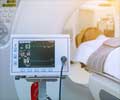Intraoperative molecular imaging using near infrared contrast identifies otherwise missed tiny tumor nodules by PET scan, by making them glow during surgery.
- Surgery is an important part of cancer treatment and preoperative PET scan imaging is standard diagnostic procedure nowadays
- PET scan detects cancer nodules accurately in 90 percent cases but still has certain limitations
- New intraoperative molecular imaging (IMI) using near infrared contrast found to improve diagnosis of missed cancer nodules by making them glow
Intramolecular Imaging – What The ResearchTeam Has to Say
Cancer treatment and diagnosis have advanced by leaps and bounds in the last two decades. Many cancers are being diagnosed early by PET scan imaging and surgery remains one of the mainstays of treatment.
- PET scans are unable to diagnose tumor nodules less than 1 cm
- Additionally, in some cases, they cannot differentiate between cancer and benign inflammatory conditions
- Most importantly, preoperative PET scans do not always reflect the ‘real-time’ situation of the patient’s tumor during surgery which could have changed in the intervening period
Diagnostic Efficacy of PET Scan And IMI Combination In Identifying Cancer
For their study, the research team chose 50 patients undergoing surgery to remove lung nodules to determine whether preoperative PET scan and intra-operative IMI combined together, improved diagnosis of cancer nodules.
- All of the patients had a pre-operative PET scan 30 days before their procedure. These scans identified a total of 66 nodules.
- The team then conducted IMI on these patients intraoperatively, using a near infrared contrast agent dubbed OTL38 that makes tumor cells glow. Prior studies had found that IMI picks up cancer nodules as tiny as 3 mm (or one-third the size of a shirt button).
- During surgery, IMI was able to correctly diagnose 60 of the 66 previously PET diagnosed nodules, or 91 percent. Additionally, IMI was able to identify nine additional nodules that were undetected by the PET scan or by traditional intraoperative monitoring.
- Overall, 75 nodules were identified between PET scan and IMI imaging
- PET scan was accurate in determining cancer nodules in 51 patients (68 percent). IMI was accurate in 68 nodules (91 percent)
- In patients evaluated in the above manner, adding IMI improved diagnosis by 30 percent. It also helped in identifying cancer in about 10 percent patients that would have been normally missed on a CT or a PET scan.
Adds the study's senior author Sunil Singhal, MD, the William Maul Measey Associate Professor in Surgical Research and director of the ACC's Center for Precision Surgery,
"This shows the contrast agent is allowing us to remove more cancer from the patient than we would have with PET imaging alone, especially when we are looking at nodules 1 centimeter or smaller".
Positron Emission Tomography (PET) Scanning
Positron emission tomography (PET) is a nuclear medicine functional imaging technique that is used to observe metabolic processes in the body by studying the uptake of a biologically active molecule such as fluoro deoxyglucose (FDG). PET scanning has several medical applications including diagnosis of tumor and metastasis and brain imaging to diagnose dementias among several others.
Scope of Current Study and Future Plans
Some of the takeaways and future plans based on the current study include the following:
- It paves the way for future research involving OTL38 contrast agent.
- This technology is now being tested in a formal, multi-center clinical trial that will be the first Phase II study of molecular imaging in the United States.
- The effectiveness of additional contrast agents, is also being explored; some of the agents might be available in the clinical setting in a few months down the line.
- These patients will also be followed up to find out if the combined PET-IMI imaging improved surgeries and patient outlook. These cancers can come back within five years in 25 to 30 percent of cases, and the team hopes that their efforts reduce the incidence of recurrences.
- Positron emission tomography - (https://en.wikipedia.org/wiki/Positron_emission_tomography)















